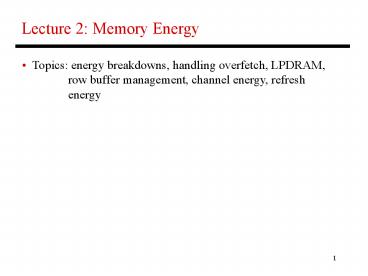Lecture 2: Memory Energy - PowerPoint PPT Presentation
Title:
Lecture 2: Memory Energy
Description:
Lecture 2: Memory Energy Topics: energy breakdowns, handling overfetch, LPDRAM, row buffer management, channel energy, refresh energy * * Power Wall Many contributors ... – PowerPoint PPT presentation
Number of Views:106
Avg rating:3.0/5.0
Title: Lecture 2: Memory Energy
1
Lecture 2 Memory Energy
- Topics energy breakdowns, handling overfetch,
LPDRAM, - row buffer management, channel
energy, refresh - energy
2
Power Wall
- Many contributors to memory power (Micron power
calc) - Overfetch
- Channel
- Buffer chips and SerDes
- Background power (output drivers)
- Leakage and refresh
3
Power Wall
- Memory system contribution (see HP power
advisor)
IBM data, from WETI 2012 talk by P. Bose
4
Overfetch
- Overfetch caused by multiple factors
- Each array is large (fewer peripherals ? more
density) - Involving more chips per access ? more data
- transfer pin bandwidth
- More overfetch ? more prefetch helps apps
with - locality
- Involving more chips per access ? less data
loss - when a chip fails ? lower overhead for
reliability
5
Re-Designing Arrays Udipi et al.,
ISCA10
6
Selective Bitline Activation
- Additional logic per array so that only relevant
bitlines - are read out
- Essentially results in finer-grain partitioning
of the DRAM - arrays
- Two papers in 2010 Udipi et al., ISCA10,
Cooper-Balis and Jacob, IEEE Micro
7
Rank Subsetting
- Instead of using all chips in a rank to read out
64-bit - words every cycle, form smaller parallel ranks
- Increases data transfer time reduces the size
of the - row buffer
- But, lower energy per row read and compatible
with - modern DRAM chips
- Increases the number of banks and hence promotes
- parallelism (reduces queuing delays)
- Initial ideas proposed in Mini-Rank (MICRO 2008)
and MC-DIMM (CAL 2008 and SC 2009)
8
DRAM Variants LPDRAM and RLDRAM
- LPDDR (low power) and RLDRAM (low latency)
Data from Chatterjee et al. (MICRO 2012)
9
LPDRAM
- Low power device operating at lower voltages and
currents - Efficient low power modes, fast exit from low
power mode - Lower bus frequencies
- Typically used in mobile systems (not in DIMMs)
10
Heterogeneous Memory Chatterjee et al.,
MICRO 2012
- Implement a few DIMMs/channels with LPDRAM and a
few - DIMMs/channels with RLDRAM
- Fetch critical data from RLDRAM and non-critical
data from - LPDRAM
- Multiple ways to classify data as critical or
not - identify hot (frequently accessed) pages
- the first word of a cache line is often critical
- Every cache line request is broken into two
requests
11
Row Buffer Management
- Open Page policy maximizes row buffer hits,
minimizes - energy
- Close Page policy helps performance when there
is - limited locality
- Hybrid policies can close a row buffer after
it has served - its utility lots of ways to predict utility
time, accesses, - locality counters for a bank, etc.
12
Micro-Pages Sudan et al.,
ASPLOS10
- Organize data across banks to maximize locality
in a - row buffer
- Key observation most locality is restricted to
a small - portion of an OS page
- Such hot micro-pages are identified with
hardware - counters and co-located on the same row
- Requires hardware indirection to a pages new
location - Works well only if most activity is confined to
a few - micro-pages
13
MemScale Deng et
al., ASPLOS 2011
- Performs DVFS on the memory controller and DFS
on the - channel
- The frequencies depend on bandwidth utilization
and - estimated energy/performance drop
- Requires no change to DRAM chips and DIMMs (in
modern - systems, the channel/DIMM frequency is set at
boot time) - Only saves energy on the processor, not on the
channel - and DIMM
14
Refresh
- Every DRAM cell must be refreshed within a 64 ms
window - A row read/write automatically refreshes the row
- Every refresh command performs refresh on a
number of - rows, the memory system is unavailable during
that time - A refresh command is issued by the memory
controller - once every 7.8us on average
15
RAIDR Liu
et al., ISCA 2012
- Process variation impacts the leakage rate for
each cell - Groups of rows are classified into bins based on
leakage - rate
- Each bin has its own refresh rate (multiples of
64ms) that - are tracked with Bloom filters
- Prior work
- Smart Refresh skip refresh for recently read
rows - Flikker non-critical data is placed in rows
that are - refreshed less frequently
16
Title
- Bullet































